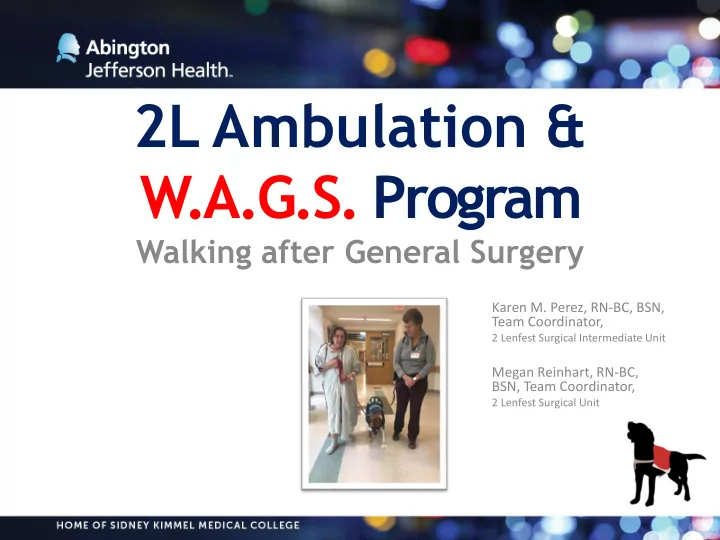

2L Ambulation & W.A.G.S. Program Walking after General Surgery Karen M. Perez, RN-BC, BSN, Team Coordinator, 2 Lenfest Surgical Intermediate Unit Megan Reinhart, RN-BC, BSN, Team Coordinator, 2 Lenfest Surgical Unit
Updated Progress (since award): 2L Ambulation Program: • Cardiology: • Heart Failure Unit Adopts Ambulation Program • Helping heart failure patients reduce post-op complications • Getting patients out of bed and ambulating sooner
Updated Progress (since award): 2L Ambulation Program: • H.E.L.P Boards: Adopted throughout the hospital. Identifies patients who are appropriate to walk with a volunteer or a Therapy Dog and their handler
Updated Progress (since award): 2L Ambulation Program: • W.A.G.S. Program • Added more dogs • Total: 3 • More engaged Patients
Updated Progress (since award): 2L Ambulation Program: • Hospital-wide Leadership Presentation • Presented Unit-based results to upper-level nursing leadership
Implementation of 2L Ambulation Program: Project Goals: • Ensure that patients are ambulating and when they are not, identify barriers to ambulation • Improve patient participation in care • Improve patient satisfaction • Implement changes hospital wide • Reassess barriers identified and find solutions in order to improve time out of bed for patients
Implementation of 2L Ambulation Program: Research: • Over a few months, ask patients about their time out of bed to chair and their time out of bed to the halls including amount of laps completed (e.g. Vascular patient vs. Bariatric Patient) • This information will be used to determine a baseline of time out of bed for a variety of different surgeries
Implementation of 2L Ambulation Program: Next Steps: • Patients will have an order in the chart for OOB – Ambulate per Protocol The order will include WHICH protocol to follow • - Laparoscopic • - Laparotomy • - Thoracic • - Lower Extremity Bypass • - Non-Operative
Implementation of 2L Ambulation Program: Next Steps: Once protocols have been agreed upon by the Surgical Attending's Order in clinical program will look like this: Once this order is placed, nursing will find the corresponding Patient Ambulation Protocol Document for the patient room
Implementation of 2L Ambulation Program: Next Steps: • Implement H.E.L.P. Board at safety huddles to assist in identifying appropriate patients for walking.
Adding Therapy DOGS Research Shows that… A growing body of research suggests that utilizing certified Animal-Assisted Therapy (AAT) dogs helps to encourage physical activity as well as reduce stress and anxiety.
Adding Therapy DOGS Research Shows that… In a systematic literature review of quantitative studies on dog-assisted interventions in healthcare, Lundqvist et al. suggest that utilizing therapy dogs had positive effects on stress and mood.
Adding Therapy DOGS Research Shows that… The official journal of the Association of Perioperative Registered Nurses states that some of the goals that can be met by using trained and certified therapy animals are: • Reducing stress preoperatively • Motivating patients to have a positive attitude • Promoting postoperative activity • Reducing the need for pain medication (Miller & Ingram, 2000).
Our Patient’s Story: • Post/Op/Day #2 Hernia Repair • PMH: Anxiety and Depression
Not Just any Dog … An AAT-Certified Dog is: • An Animal-Assisted Therapy (AAT) certified animal who participates in structured programs designed by health care professionals • A dog who has this specialty certification
Questions?
Recommend
More recommend